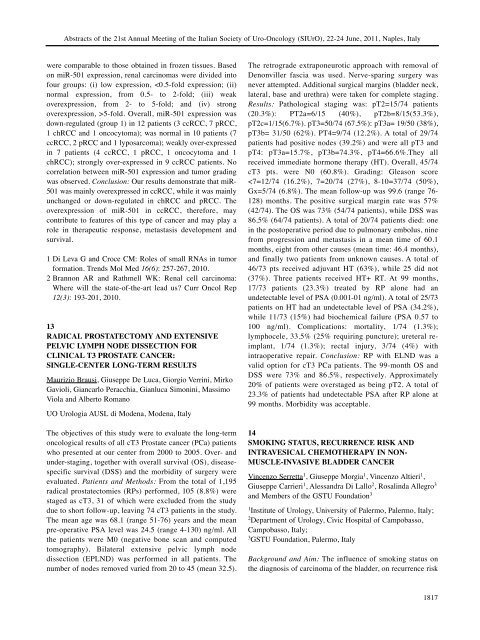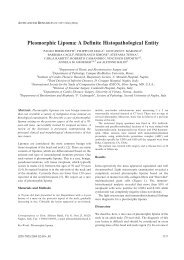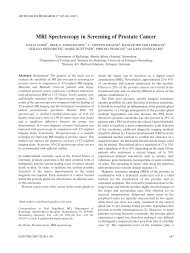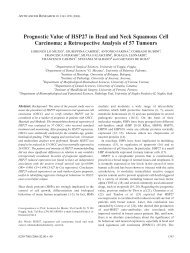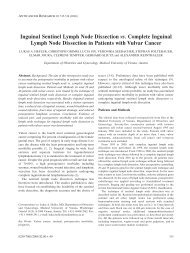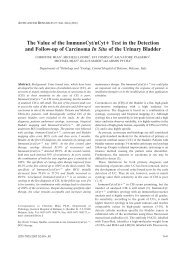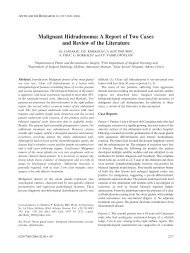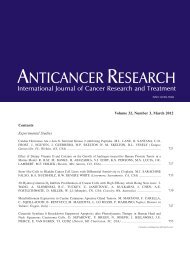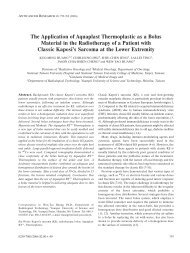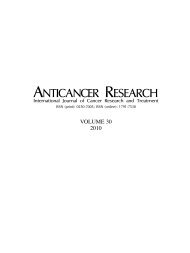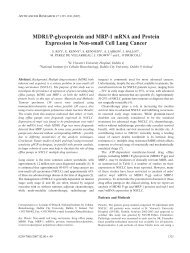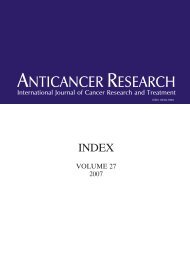ABSTRACTS OF THE 21st ANNUAL MEETING OF THE ITALIAN ...
ABSTRACTS OF THE 21st ANNUAL MEETING OF THE ITALIAN ...
ABSTRACTS OF THE 21st ANNUAL MEETING OF THE ITALIAN ...
Create successful ePaper yourself
Turn your PDF publications into a flip-book with our unique Google optimized e-Paper software.
Abstracts of the <strong>21st</strong> Annual Meeting of the Italian Society of Uro-Oncology (SIUrO), 22-24 June, 2011, Naples, Italy<br />
were comparable to those obtained in frozen tissues. Based<br />
on miR-501 expression, renal carcinomas were divided into<br />
four groups: (i) low expression, 5-fold. Overall, miR-501 expression was<br />
down-regulated (group 1) in 12 patients (3 ccRCC, 7 pRCC,<br />
1 chRCC and 1 oncocytoma); was normal in 10 patients (7<br />
ccRCC, 2 pRCC and 1 lyposarcoma); weakly over-expressed<br />
in 7 patients (4 ccRCC, 1 pRCC, 1 oncocytoma and 1<br />
chRCC); strongly over-expressed in 9 ccRCC patients. No<br />
correlation between miR-501 expression and tumor grading<br />
was observed. Conclusion: Our results demonstrate that miR-<br />
501 was mainly overexpressed in ccRCC, while it was mainly<br />
unchanged or down-regulated in chRCC and pRCC. The<br />
overexpression of miR-501 in ccRCC, therefore, may<br />
contribute to features of this type of cancer and may play a<br />
role in therapeutic response, metastasis development and<br />
survival.<br />
1 Di Leva G and Croce CM: Roles of small RNAs in tumor<br />
formation. Trends Mol Med 16(6): 257-267, 2010.<br />
2 Brannon AR and Rathmell WK: Renal cell carcinoma:<br />
Where will the state-of-the-art lead us? Curr Oncol Rep<br />
12(3): 193-201, 2010.<br />
13<br />
RADICAL PROSTATECTOMY AND EXTENSIVE<br />
PELVIC LYMPH NODE DISSECTION FOR<br />
CLINICAL T3 PROSTATE CANCER:<br />
SINGLE-CENTER LONG-TERM RESULTS<br />
Maurizio Brausi, Giuseppe De Luca, Giorgio Verrini, Mirko<br />
Gavioli, Giancarlo Peracchia, Gianluca Simonini, Massimo<br />
Viola and Alberto Romano<br />
UO Urologia AUSL di Modena, Modena, Italy<br />
The objectives of this study were to evaluate the long-term<br />
oncological results of all cT3 Prostate cancer (PCa) patients<br />
who presented at our center from 2000 to 2005. Over- and<br />
under-staging, together with overall survival (OS), diseasespecific<br />
survival (DSS) and the morbidity of surgery were<br />
evaluated. Patients and Methods: From the total of 1,195<br />
radical prostatectomies (RPs) performed, 105 (8.8%) were<br />
staged as cT3, 31 of which were excluded from the study<br />
due to short follow-up, leaving 74 cT3 patients in the study.<br />
The mean age was 68.1 (range 51-76) years and the mean<br />
pre-operative PSA level was 24.5 (range 4-130) ng/ml. All<br />
the patients were M0 (negative bone scan and computed<br />
tomography). Bilateral extensive pelvic lymph node<br />
dissection (EPLND) was performed in all patients. The<br />
number of nodes removed varied from 20 to 45 (mean 32.5).<br />
The retrograde extraponeurotic approach with removal of<br />
Denonviller fascia was used. Nerve-sparing surgery was<br />
never attempted. Additional surgical margins (bladder neck,<br />
lateral, base and urethra) were taken for complete staging.<br />
Results: Pathological staging was: pT2=15/74 patients<br />
(20.3%): PT2a=6/15 (40%), pT2b=8/15(53.3%),<br />
pT2c=1/15(6.7%). pT3=50/74 (67.5%): pT3a= 19/50 (38%),<br />
pT3b= 31/50 (62%). PT4=9/74 (12.2%). A total of 29/74<br />
patients had positive nodes (39.2%) and were all pT3 and<br />
pT4: pT3a=15.7%, pT3b=74.3%, pT4=66.6%.They all<br />
received immediate hormone therapy (HT). Overall, 45/74<br />
cT3 pts. were N0 (60.8%). Grading: Gleason score<br />


